 by "RamblinRover Luxury-Yacht" (ramblininexile)
by "RamblinRover Luxury-Yacht" (ramblininexile)
Published 03/20/2017 at 11:30
 by "RamblinRover Luxury-Yacht" (ramblininexile)
by "RamblinRover Luxury-Yacht" (ramblininexile)
Published 03/20/2017 at 11:30
Tags: suspension
; dammit ferd
; tech articles
STARS: 5

In 1962, Ford had a perfectly okay LCA setup for the fullsize models. Double A-arm, caster and camber adjust at the top A-arm, leading steer. Nothing horribly deranged - that had to change...
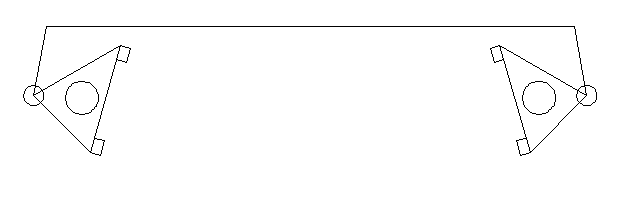
The arms are tilted forward, making the setup leading-arm style, which is good thinking, mostly. Torque transfer under braking fights dive, etc. etc. But it wasn’t complicated enough. See, if you’re braking at low speed, the toe-in can change slightly, making it resist turning off-straight a little bit, and when experiencing a one-wheel bump, the setup sees some bump-steer. Neither is too good for unassisted steering, which was still standard. WE MUST FIX THIS FOR GRANDMAS AND THE CHILDRENS. AND THE ‘63 MODEL YEAR.
Most people would put in a steering stabilizer or redesign the linkage geometry. Is that what happened? Is that balls. No, Ford decided that the suspension needed to move around more. Wait, that’s not a solution. That’s idiotic.
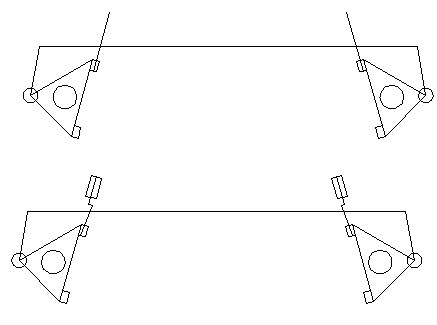
The “solution” was to make a much larger boss through the frame and install the bolt system visible at the top of this post. A tiny little crank, allowing the front end of the LCA to travel inward and outward based on the balance of forces, a limited amount. I’m still puzzling out elements of this, but I think it’s something like this:

The LCA is a trapezoid of force, spring pushing down, spindle and frame mounts pulling back up. Think of it as a finger pushing down on a wobbly four-sided die. The neutral position (held in tension by the steering link, etc.) is with the “crank” slightly inward and down. When a bump hits (green), a normal A-arm would pivot and compress the suspension, but with this, something else happens first. The trapezoid “tilts” around the spring, and the crank goes down and out, causing the instantaneous caster, camber, and toe-in on that side *all* to change, and muting the instant movement transferred to the shock.
The wheel will tend to begin to dodge away from the hole, i.e. bump steer - but before it’s done bump-steering, the crank swings back the other way, past its neutral position, which would cause the bump-steer to get canceled.
Summary: worse instantaneous bump steer, but lessened shock to the car, and the bump-steer cancels itself out after a drunken swing. Ford, WHAT THE FUCK.
In cornering, the outer wheel will tend to try to push in, and the inner wheel will try to pull out. For that, the Ford MoronoCrank System also has you covered.
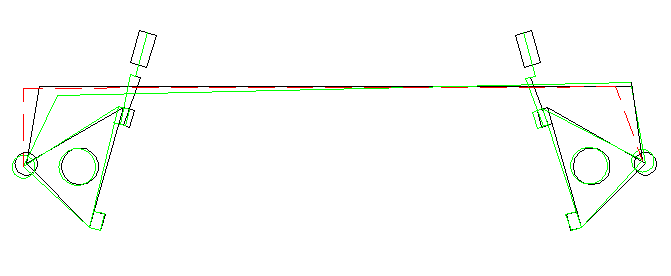
Under normal steering (left turn, red line pittman position) the inward push of the right A-arm and outward extension of the left A-arm works okay - toe relation, relative angle change, all pretty consistent between the two sides, and as a plus, the wheels have actually changed position to improve their alignment to the turning radius. Neat.
This all changes if you’re braking hard. As the car shifts from neutral position to a right turn while braking, the arms can shift the same way as a neutral/accelerating left turn, and the left wheel “digs in” - SHARPLY (green linkage). The right wheel (inside), actually doesn’t do much. This makes manual steering much easier, because the outside wheel is getting “assisted”. However, at speed, this is... REALLY DANGEROUS, because it’s a recipe for the car swinging back and forth depending on how much the instant wheel drag is pulling on the suspension.
As a side note, the system does have a fringe benefit that I discovered by accident. If your brakes aren’t working right and one wheel locks up, it will *not* pull the car out of a straight line, particularly.
!!! UNKNOWN CONTENT TYPE !!!
Well, as it turns out, this system, being completely undamped and really sensitive to weight shifts was a *REALLY* bad idea for big-block cars and less than a great idea for ordinary cars. Lurching back and forth at speed, wobbling while under braking, and otherwise being terrifying - plus, it wears out the front LCA bushing like a mofo (angle is always changing) *AND* likes to work loose. Huzzah.
Ford were aware of this. They offered for performance models and cop cars/taxis a bar which would tie the two cranks together. Not a straight bolt system, because that would make too much sense. Very soon, several aftermarket bars also showed up, along with kits to replace with straight bolts (and not cranks). Moog offered a rubber-bushed brace instead of the bar, which located the crank to the front crossmember. Some people even welded the cranks in place.
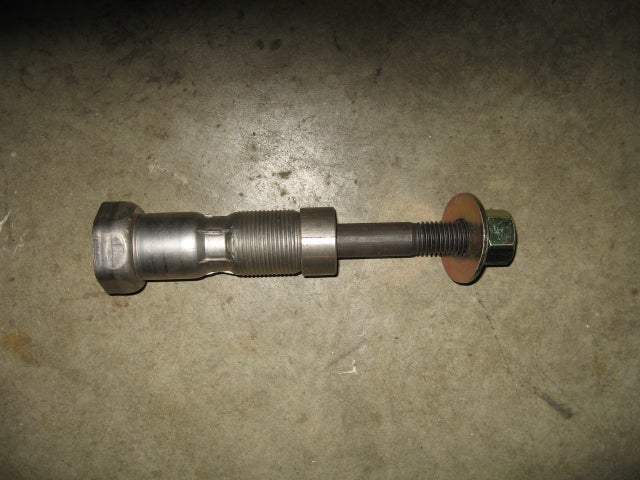

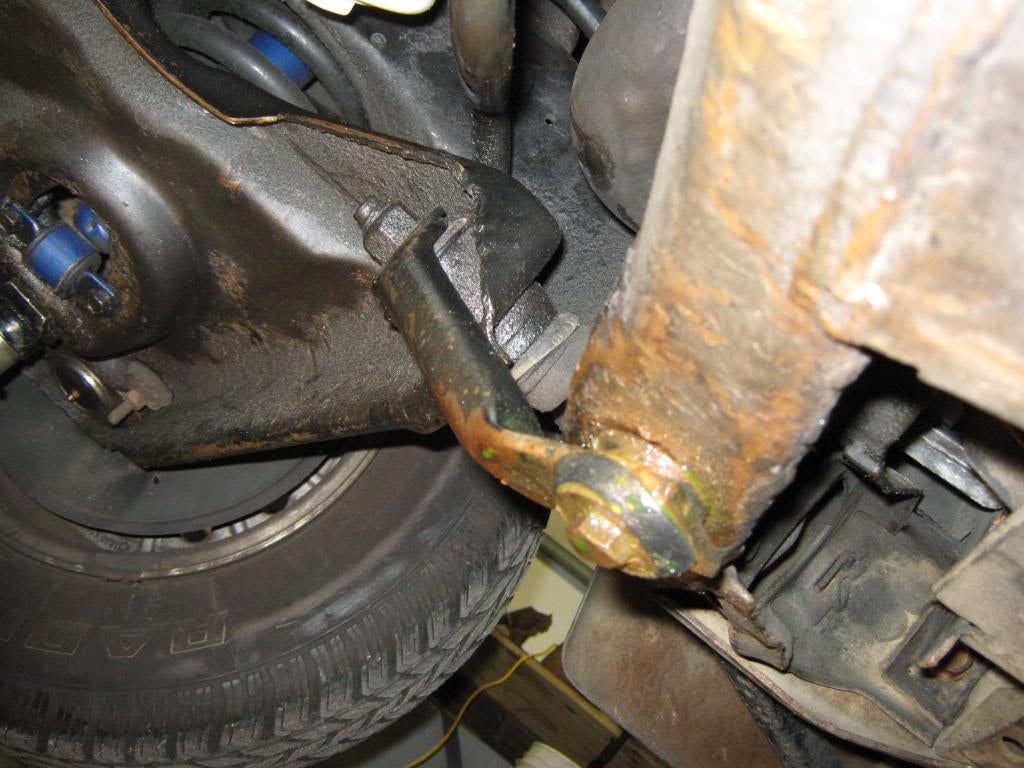
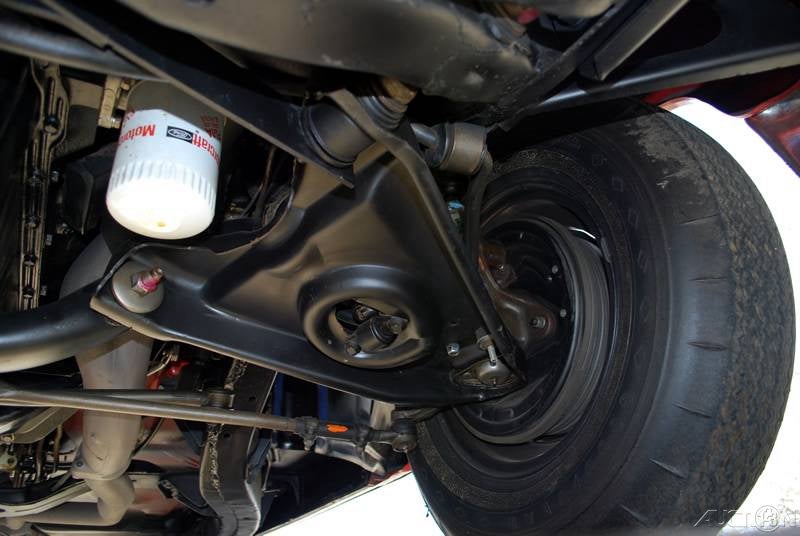
So, what’s the best solution? If you like the car to feel as much as possible like a waterbed (and who doesn’t!), then you need to rebuild the offset shafts. This is a pain, because the offset shafts were only on cars ‘63-’64, and in ‘65 they changed the suspension completely. They are greasable, but most are worn out, and replacements are limited and expensive.
The straight shaft conversion of original style bushings and the Rare Parts offset straight shaft are both insanely expensive as well. (Typically >$300) There is an adjustable cross-bar available for ~$100 and a non-adjustable for more like $70 - both will preserve a *little bit* of factory design wobble and will reduce wear, but they require the original system to be in place.
So, what drove me to research all this? The fact that my ‘63 is loose on the left front and slapping like a sumo wrestler’s little sister. Obviously.
Ford: designing suspensions systems that wobble on purpose and try to kill you since about drunk o’clock this morning.
 "RamblinRover Luxury-Yacht" (ramblininexile)
"RamblinRover Luxury-Yacht" (ramblininexile)
03/20/2017 at 11:38, STARS: 3
I left out of this, of course - this suspension setup could drive your alignment shop absolutely batfuck nuts. Tighten the toe-in, car draws up on the cranks, car settles, toe changes. Crank on one side sticks just slightly, camber ends up all wrong, adjust, camber, caster, and toe all change again when it moves.
 "uofime-2" (uofime-2)
"uofime-2" (uofime-2)
03/20/2017 at 12:30, STARS: 0
wow, sounds fun!
 "uofime-2" (uofime-2)
"uofime-2" (uofime-2)
03/20/2017 at 12:31, STARS: 0
So, how do you suppose this happened?
Did they just not think through all the possible modes of operation when they approved the design or did they just not think it mattered?
 "RamblinRover Luxury-Yacht" (ramblininexile)
"RamblinRover Luxury-Yacht" (ramblininexile)
03/20/2017 at 12:48, STARS: 0
Probably didn’t think it mattered. There are already a couple of flaws in the suspension as a whole - accelerated upper ball joint wear for one, and in some ways on a very bumpy road at medium speeds it helps to quash nasty feedback and make the steering smooth. Anybody who needed performance, this was not going to work, but for an ordinary driver it helped with the whole floating cloud thing.
I also suspect that it misbehaves more than they anticipated, and while they’d have been fine with some accelerated wear, I think there’s too much, looking back.
Remember, this did add a couple dollars to the build cost, so was definitely considered an improvement, although (tellingly, perhaps) not as much as reengineering the spindles or adding a damper/etc. would have. The LCA is different from a ‘62, the crossmember is different, and there are around 5-6 more pieces, so it’s not a trivial piece of madness.
 "uofime-2" (uofime-2)
"uofime-2" (uofime-2)
03/20/2017 at 13:31, STARS: 0
Maybe they were trying to avoid changing mounting points on the chassis to avoid inventory and tooling changes there and they thought this would be cheaper on a per unit basis. you said it was a two year change, have to think they were working on the next model year while implementing this change as well, maybe it was just the best they could do.
 "RamblinRover Luxury-Yacht" (ramblininexile)
"RamblinRover Luxury-Yacht" (ramblininexile)
03/20/2017 at 13:49, STARS: 0
Well, that’s the thing. They *did* change mounting points on the chassis. The boss on the front crossmember that the LCA bolt goes through is completely different on the “crank” models, and the LCA itself is different. That has to have involved some tooling, template, and jig changes. They clearly thought it was (at least sort of) a good idea.
One way it would help to think of the system is as if the steering links were hooked to the wheels via a “spring”, with the spring balancing force provided by the weight of the car. Softens and smooths out the steering inputs and feedback, manages some bumps better... and does some bad things, only some of which were predicted.
People talk about car design (including suspension design) as an art of compromise... but it’s rare that the automaker will go so far in pursuit of a
notional
improvement that they’re willing to fuck the car up in another area (or several) this badly.
I’ve seen a silly Ford compromise for improved ride - it’s called using a super-soft spring on Falcons and making it not have Baja-travel suspension by preloading it three whole inches with the shock. Goofy, but only sort of deranged. This - this is actually crazy. On a 390 car, it’s diving so much under the heavy engine when braking hard that the toe-in change is likely to make it impossible to steer away from straight and will eat the tires - small wonder that the police 390s got a brace. On my 289 car, it *only* feels like the wheel positions are being determined by a Rube Goldberg device with lots of rubber links and possibly some gnomes.
If it had worked out, we might have seen a “crank” on the outer end of the bar-style LCA on a ‘65. However, since it didn’t, we didn’t.
 "uofime-2" (uofime-2)
"uofime-2" (uofime-2)
03/20/2017 at 14:09, STARS: 0
Your pictures were good enough to understand what they were trying to do and it really is novel having a passive extra link that dynamically changes the geometry.
I wonder how many other unique designs that made it to production exist in the world
 "RamblinRover Luxury-Yacht" (ramblininexile)
"RamblinRover Luxury-Yacht" (ramblininexile)
03/20/2017 at 14:40, STARS: 0
Honestly, it probably would have worked great if there had been a brace on all of the cars of a more advanced design - say, with rubber bushes on each end to make sure the crank could still move properly. A brace with a good end design would have damped the crank movement (while still allowing some), prevented erratic behavior on dive, and prevented the “one wheel bite” scenario when cornering, to a point. Wouldn’t have self-corrected on a bump as quickly, but it also wouldn’t have bump-steered so far.
In other words, Ford executed a clever (but crazy) idea pretty badly, came up with a partial fix that was almost meant to *undo* the change, and just barely missed being a *perfect* fix to produce a “weird but kind of good”. Getting close most likely by accident and missing perfect through laziness. Immediately before rolling out a new model that made all of that completely moot.
Hey, this sounds like some of the issues with the Fox/SN95 rear suspension, somehow...
Your pictures were good enough to understand what they were trying to do
Misuse of AutoCAD at work FTW.
 "uofime-2" (uofime-2)
"uofime-2" (uofime-2)
03/20/2017 at 14:45, STARS: 0
Some things never change!
 "RamblinRover Luxury-Yacht" (ramblininexile)
"RamblinRover Luxury-Yacht" (ramblininexile)
03/20/2017 at 14:51, STARS: 1
I like to think whoever got handed the job of doing the ‘65 clean sheet was handed the ‘63/’64 and asked “can you make something kind of like this but more in line with the small cars, and cheaper to make”, and that his mental response to the ‘63/’64 was “what... how in the fuck... so then you.. and it... WHY”
 "Aremmes" (aremmes)
"Aremmes" (aremmes)
03/20/2017 at 15:28, STARS: 0
And here I thought that Miatas were difficult to align. This nugget of information has thoroughly disabused me of that notion.
 "RamblinRover Luxury-Yacht" (ramblininexile)
"RamblinRover Luxury-Yacht" (ramblininexile)
03/20/2017 at 15:35, STARS: 0
Mercedes W124s are irritating because you have the tie rod positioned (I guess for anti-bumpsteer reasons) in such a way that adjustments to caster and camber (done at the LCA) tend to fuck with the toe setting unpredictably. I think the correct procedure is to roll the wheel to neutral yaw (regardless of toe), set camber *then* tweak to caster, *then* do the other side, *then* do toe, then recheck caster. A lot harder than they appear, and has to be done on a rack. My local shop had quite a time of it, even with new bushings all through.
I’ll say this for the Galaxie - if you can keep the little cranks where they’re supposed to be (like, say, with the brace I mentioned) it isn’t too hard to mess with the setup. The upper control arm sets with shims which you can drop into place straight from above, in the engine compartment. Very easy.
 "Die-Trying" (die-trying)
"Die-Trying" (die-trying)
03/20/2017 at 16:16, STARS: 0
“adaptive steering”.........
 "RamblinRover Luxury-Yacht" (ramblininexile)
"RamblinRover Luxury-Yacht" (ramblininexile)
03/20/2017 at 16:18, STARS: 1
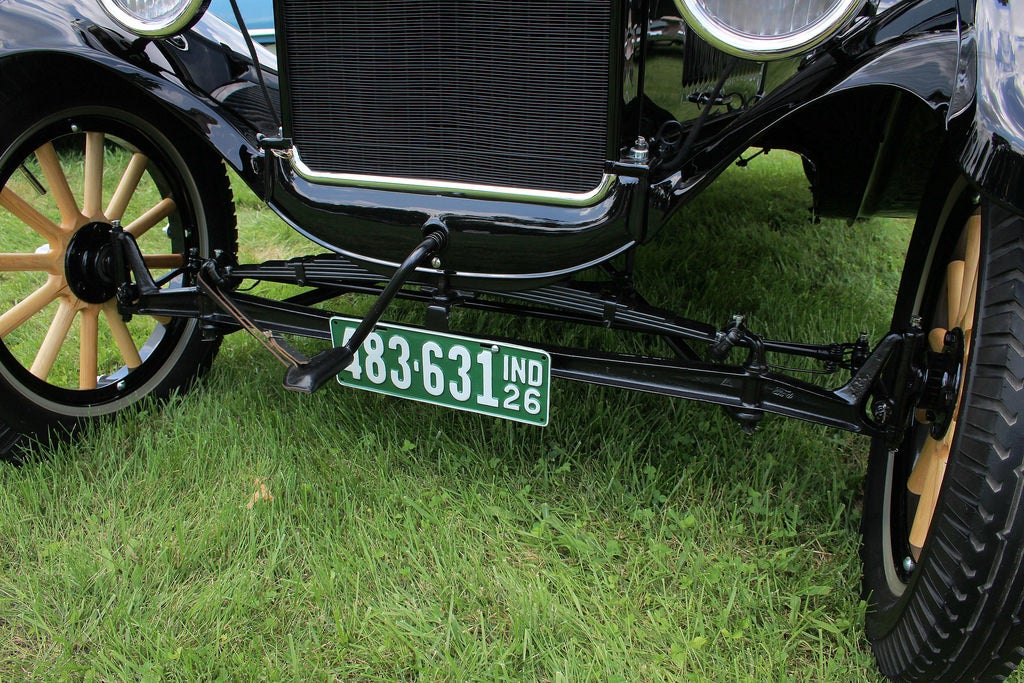
I just had an unsettling idea. I had this nagging feeling that I’d seen a front suspension with an ability to “crank” somewhere, and I remembered where: the Model T. Granted, it’s not something that affects steering particularly, but there *is* at least one other type of steering setup that alters wheel position, distance from body, and camber in reaction to a bump, and this is it - the double shackles on a Model T.
Probably a coincidence, but a hint that “loose” suspension has a history at Ford.
 "RamblinRover Luxury-Yacht" (ramblininexile)
"RamblinRover Luxury-Yacht" (ramblininexile)
03/20/2017 at 16:20, STARS: 1
“wheels that steer themselves at least partly independently of the steering wheel position, based on whatever they feel like doing at that instant”
 "RallyWrench" (rndlitebmw)
"RallyWrench" (rndlitebmw)
03/22/2017 at 00:29, STARS: 0
I... had no idea. That bolt, uh, thing, how could something so fucky make it off a drawing board?!? Suddenly my I-beams seem downright sensible, in the way that a suspension that can’t be aligned and wages war on tires by design is sensible. At least it’s durable, it doesn’t seem this even has that going for it.
Now I need to go seek the rabbit hole of period Galaxie race cars to see what they did.
 "RallyWrench" (rndlitebmw)
"RallyWrench" (rndlitebmw)
03/22/2017 at 00:29, STARS: 0
I... had no idea. That bolt, uh, thing, how could something so fucky make it off a drawing board?!? Suddenly my I-beams seem downright sensible, in the way that a suspension that can’t be aligned and wages war on tires by design is sensible. At least it’s durable, it doesn’t seem this even has that going for it.
 "RallyWrench" (rndlitebmw)
"RallyWrench" (rndlitebmw)
03/22/2017 at 00:48, STARS: 0
I read your preceding supplement post on the alignment, and was going to say, “what about a Mercedes like yours blah blah etc”, then scrolled down to this one and nodded in approval. Much sneaking up on numbers with those.
 "RamblinRover Luxury-Yacht" (ramblininexile)
"RamblinRover Luxury-Yacht" (ramblininexile)
03/22/2017 at 09:07, STARS: 0
Hilariously, most ‘63 Galaxie 427s were made with ‘62 chassis, because they went into development before the madness set in. I think most race cars actually built with the these chassis were braced or set up with straight bolts.
At least I-beams have good roll center characteristics and mostly act like a straight axle without jacking both wheels at once. And, y’know, don’t act like the steering link is connected with a seesaw to the wheels.